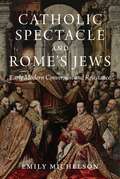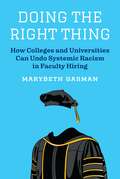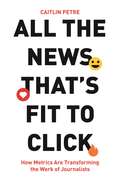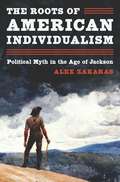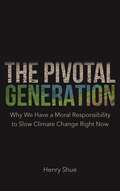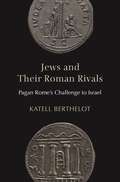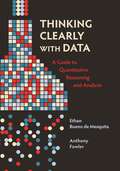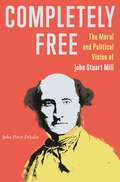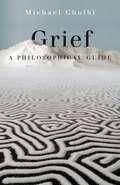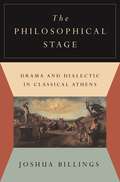- Table View
- List View
Who Really Wrote the Bible: The Story of the Scribes
by William M. SchniedewindA groundbreaking new account of the writing of the Hebrew BibleWho wrote the Bible? Its books have no bylines. Tradition long identified Moses as the author of the Pentateuch, with Ezra as editor. Ancient readers also suggested that David wrote the psalms and Solomon wrote Proverbs and Qohelet. Although the Hebrew Bible rarely speaks of its authors, people have been fascinated by the question of its authorship since ancient times. In Who Really Wrote the Bible, William Schniedewind offers a bold new answer: the Bible was not written by a single author, or by a series of single authors, but by communities of scribes. The Bible does not name its authors because authorship itself was an idea enshrined in a later era by the ancient Greeks. In the pre-Hellenistic world of ancient Near Eastern literature, books were produced, preserved, and passed on by scribal communities.Schniedewind draws on ancient inscriptions, archaeology, and anthropology, as well as a close reading of the biblical text itself, to trace the communal origin of biblical literature. Scribes were educated through apprenticeship rather than in schools. The prophet Isaiah, for example, has his &“disciples&”; Elisha has his &“apprentice.&” This mode of learning emphasized the need to pass along the traditions of a community of practice rather than to individuate and invent. Schniedewind shows that it is anachronistic to impose our ideas about individual authorship and authors on the writing of the Bible. Ancient Israelites didn&’t live in books, he writes, but along dusty highways and byways. Who Really Wrote the Bible describes how scribes and their apprentices actually worked in ancient Jerusalem and Judah.
Who Really Wrote the Bible: The Story of the Scribes
by William M. SchniedewindA groundbreaking new account of the writing of the Hebrew BibleWho wrote the Bible? Its books have no bylines. Tradition long identified Moses as the author of the Pentateuch, with Ezra as editor. Ancient readers also suggested that David wrote the psalms and Solomon wrote Proverbs and Qohelet. Although the Hebrew Bible rarely speaks of its authors, people have been fascinated by the question of its authorship since ancient times. In Who Really Wrote the Bible, William Schniedewind offers a bold new answer: the Bible was not written by a single author, or by a series of single authors, but by communities of scribes. The Bible does not name its authors because authorship itself was an idea enshrined in a later era by the ancient Greeks. In the pre-Hellenistic world of ancient Near Eastern literature, books were produced, preserved, and passed on by scribal communities.Schniedewind draws on ancient inscriptions, archaeology, and anthropology, as well as a close reading of the biblical text itself, to trace the communal origin of biblical literature. Scribes were educated through apprenticeship rather than in schools. The prophet Isaiah, for example, has his &“disciples&”; Elisha has his &“apprentice.&” This mode of learning emphasized the need to pass along the traditions of a community of practice rather than to individuate and invent. Schniedewind shows that it is anachronistic to impose our ideas about individual authorship and authors on the writing of the Bible. Ancient Israelites didn&’t live in books, he writes, but along dusty highways and byways. Who Really Wrote the Bible describes how scribes and their apprentices actually worked in ancient Jerusalem and Judah.
Catholic Spectacle and Rome's Jews: Early Modern Conversion and Resistance
by Dr Emily MichelsonA new investigation that shows how conversionary preaching to Jews was essential to the early modern Catholic Church and the Roman religious landscapeStarting in the sixteenth century, Jews in Rome were forced, every Saturday, to attend a hostile sermon aimed at their conversion. Harshly policed, they were made to march en masse toward the sermon and sit through it, all the while scrutinized by local Christians, foreign visitors, and potential converts. In Catholic Spectacle and Rome’s Jews, Emily Michelson demonstrates how this display was vital to the development of early modern Catholicism.Drawing from a trove of overlooked manuscripts, Michelson reconstructs the dynamics of weekly forced preaching in Rome. As the Catholic Church began to embark on worldwide missions, sermons to Jews offered a unique opportunity to define and defend its new triumphalist, global outlook. They became a point of prestige in Rome. The city’s most important organizations invested in maintaining these spectacles, and foreign tourists eagerly attended them. The title of “Preacher to the Jews” could make a man’s career. The presence of Christian spectators, Roman and foreign, was integral to these sermons, and preachers played to the gallery. Conversionary sermons also provided an intellectual veneer to mask ongoing anti-Jewish aggressions. In response, Jews mounted a campaign of resistance, using any means available.Examining the history and content of sermons to Jews over two and a half centuries, Catholic Spectacle and Rome’s Jews argues that conversionary preaching to Jews played a fundamental role in forming early modern Catholic identity.
Horizon Work: At the Edges of Knowledge in an Age of Runaway Climate Change
by Adriana PetrynaA new way of thinking about the climate crisis as an exercise in delimiting knowable, and habitable, worldsAs carbon dioxide emissions continue to rise, Earth’s fragile ecosystems are growing increasingly unstable and unpredictable. Horizon Work explores how climate change is disrupting our fundamental ability to project how the environment will act over time, and how these rapidly faltering predictions are colliding with the dangerous new realities of emergency response.Anthropologist Adriana Petryna examines the climate crisis through the lens of “horizoning,” a mode of reckoning that considers unnatural disasters against a horizon of expectation in which people and societies can act. She talks to wildfire scientists who, amid chaotic fire seasons and shifting fire behaviors, are revising predictive models calibrated to conditions that no longer exist. Petryna tells the stories of wildland firefighters who could once rely on memory of previous fires to gauge the behaviors of the next. Trust in patterns has become an occupational hazard. Sometimes, the very concept of projection becomes untenable. Yet if all we see is doom, we will overlook something crucial about the scientific and ethical labor needed to hold back climate chaos. Here is where the work of horizoning begins.From experiments probing our planetary points of no return to disaster ecologies where the stark realities of climate change are being confronted, Horizon Work reveals how this new way of thinking has the power to reverse harmful legacies while turning voids where projection falters into spaces of collective action and recoverable futures.
The Idea of Prison Abolition (Carl G. Hempel Lecture Series #13)
by Tommie ShelbyAn incisive and sympathetic examination of the case for ending the practice of imprisonmentDespite its omnipresence and long history, imprisonment is a deeply troubling practice. In the United States and elsewhere, prison conditions are inhumane, prisoners are treated without dignity, and sentences are extremely harsh. Mass incarceration and its devastating impact on black communities have been widely condemned as neoslavery or &“the new Jim Crow.&” Can the practice of imprisonment be reformed, or does justice require it to be ended altogether? In The Idea of Prison Abolition, Tommie Shelby examines the abolitionist case against prisons and its formidable challenge to would-be prison reformers.Philosophers have long theorized punishment and its justifications, but they haven&’t paid enough attention to incarceration or its related problems in societies structured by racial and economic injustice. Taking up this urgent topic, Shelby argues that prisons, once reformed and under the right circumstances, can be legitimate and effective tools of crime control. Yet he draws on insights from black radicals and leading prison abolitionists, especially Angela Davis, to argue that we should dramatically decrease imprisonment and think beyond bars when responding to the problem of crime.While a world without prisons might be utopian, The Idea of Prison Abolition makes the case that we can make meaningful progress toward this ideal by abolishing the structural injustices that too often lead to crime and its harmful consequences.
Doing the Right Thing: How Colleges and Universities Can Undo Systemic Racism in Faculty Hiring
by Marybeth GasmanAn honest confrontation of systemic racism in faculty hiring—and what to do about itWhile colleges and universities have been lauded for increasing student diversity, these same institutions have failed to achieve any comparable diversity among their faculty. In 2017, of the nation’s full-time, tenure-track and tenured faculty, only 3 percent each were Black men, Black women, Hispanic men, and Hispanic women. Only 6 percent were Asian/Pacific Islander men, 5 percent were Asian/Pacific Islander women, and 1 percent were American Indian/Alaska Native. Why are the numbers so abysmal? In Doing the Right Thing, Marybeth Gasman takes a hard, insightful look at the issues surrounding the recruitment and hiring of faculty of color. Relying on national data and interviews with provosts, deans, and department chairs from sixty major universities, Gasman documents the institutional forces stymieing faculty diversification, and she makes the case for how such deficiencies can and should be rectified.Even as institutions publicly champion inclusive excellence and the number of doctoral students of color increases, Gasman reveals the entrenched constraints contributing to the faculty status quo. Impediments to progress include the alleged trade-off between quality and diversity, the power of pedigree, the rigidity of academic pipelines, failures of administrative leadership, lack of accountability among administration and faculty, and the opacity and arbitrariness of the recruitment and hiring process. Gasman contends that leaders must acknowledge institutional failures of inclusion, pervasive systemic racism, and biases that restrict people of color from pursuing faculty careers.Recognizing that individuals from all backgrounds are essential to the creation and teaching of knowledge, Doing the Right Thing puts forth a concrete call for colleges and universities to take action and do better.
The Network of Life: A New View of Evolution
by David P. MindellWhy evolution is like a network, not a family tree—and why it matters for understanding the health of all living thingsIn The Network of Life, David Mindell explains why the conventional narrative of evolution needs to evolve. Ever since Darwin, evolution has largely been thought to work like a family tree in which species are related through a series of branching events. But, today, a growing knowledge of the ways species share genetic materials in a process known as horizontal evolution has revealed that evolution is actually a network of shared genealogy in which species are more interconnected than previously thought. In this book, Mindell presents this new narrative of life&’s evolution and its profound implications for all life on Earth.The Network of Life describes the drivers of horizontal evolution—interbreeding and genetic recombination, the merger of species, horizontal gene transfer, and coevolution. The network view of evolution that emerges supports a new symbiotic theory of health, which holds that the future health of humans, other species, and our shared environments depends on evolution and adaptation across life&’s network.Difficult times lie ahead for many of Earth&’s species as climates and habitats transform. At the same time, new and altered life-forms are arising and spreading in association with human activities. We are also learning to reshape and create life by mimicking the mechanisms of horizontal evolution, and we are coevolving with technology as we enhance our bodies, brains, and life spans. The Network of Life shows why and how increasing our knowledge of horizontal evolution can provide critical lessons as we navigate our looming challenges.
The Network of Life: A New View of Evolution
by David P. MindellWhy evolution is like a network, not a family tree—and why it matters for understanding the health of all living thingsIn The Network of Life, David Mindell explains why the conventional narrative of evolution needs to evolve. Ever since Darwin, evolution has largely been thought to work like a family tree in which species are related through a series of branching events. But, today, a growing knowledge of the ways species share genetic materials in a process known as horizontal evolution has revealed that evolution is actually a network of shared genealogy in which species are more interconnected than previously thought. In this book, Mindell presents this new narrative of life&’s evolution and its profound implications for all life on Earth.The Network of Life describes the drivers of horizontal evolution—interbreeding and genetic recombination, the merger of species, horizontal gene transfer, and coevolution. The network view of evolution that emerges supports a new symbiotic theory of health, which holds that the future health of humans, other species, and our shared environments depends on evolution and adaptation across life&’s network.Difficult times lie ahead for many of Earth&’s species as climates and habitats transform. At the same time, new and altered life-forms are arising and spreading in association with human activities. We are also learning to reshape and create life by mimicking the mechanisms of horizontal evolution, and we are coevolving with technology as we enhance our bodies, brains, and life spans. The Network of Life shows why and how increasing our knowledge of horizontal evolution can provide critical lessons as we navigate our looming challenges.
All the News That’s Fit to Click: How Metrics Are Transforming the Work of Journalists
by Caitlin PetreFrom the New York Times to Gawker, a behind-the-scenes look at how performance analytics are transforming journalism today—and how they might remake other professions tomorrowJournalists today are inundated with data about which stories attract the most clicks, likes, comments, and shares. These metrics influence what stories are written, how news is promoted, and even which journalists get hired and fired. Do metrics make journalists more accountable to the public? Or are these data tools the contemporary equivalent of a stopwatch wielded by a factory boss, worsening newsroom working conditions and journalism quality? In All the News That's Fit to Click, Caitlin Petre takes readers behind the scenes at the New York Times, Gawker, and the prominent news analytics company Chartbeat to explore how performance metrics are transforming the work of journalism.Petre describes how digital metrics are a powerful but insidious new form of managerial surveillance and discipline. Real-time analytics tools are designed to win the trust and loyalty of wary journalists by mimicking key features of addictive games, including immersive displays, instant feedback, and constantly updated “scores” and rankings. Many journalists get hooked on metrics—and pressure themselves to work ever harder to boost their numbers.Yet this is not a simple story of managerial domination. Contrary to the typical perception of metrics as inevitably disempowering, Petre shows how some journalists leverage metrics to their advantage, using them to advocate for their professional worth and autonomy.An eye-opening account of data-driven journalism, All the News That's Fit to Click is also an important preview of how the metrics revolution may transform other professions.
The Roots of American Individualism: Political Myth in the Age of Jackson
by Alex ZakarasA panoramic history of American individualism from its nineteenth-century origins to today’s bitterly divided politicsIndividualism is a defining feature of American public life. Its influence is pervasive today, with liberals and conservatives alike promising to expand personal freedom and defend individual rights against unwanted intrusion, be it from big government, big corporations, or intolerant majorities. The Roots of American Individualism traces the origins of individualist ideas to the turbulent political controversies of the Jacksonian era (1820–1850) and explores their enduring influence on American politics and culture.Alex Zakaras plunges readers into the spirited and rancorous political debates of Andrew Jackson’s America, drawing on the stump speeches, newspaper editorials, magazine articles, and sermons that captivated mass audiences and shaped partisan identities. He shows how these debates popularized three powerful myths that celebrated the young nation as an exceptional land of liberty: the myth of the independent proprietor, the myth of the rights-bearer, and the myth of the self-made man.The Roots of American Individualism reveals how generations of politicians, pundits, and provocateurs have invoked these myths for competing political purposes. Time and again, the myths were used to determine who would enjoy equal rights and freedoms and who would not. They also conjured up heavily idealized, apolitical visions of social harmony and boundless opportunity, typically centered on the free market, that have distorted American political thought to this day.
The Pivotal Generation: Why We Have a Moral Responsibility to Slow Climate Change Right Now
by Henry ShueAn eminent philosopher explains why we owe it to future generations to take immediate action on global warmingClimate change is the supreme challenge of our time. Yet despite growing international recognition of the unfolding catastrophe, global carbon emissions continue to rise, hitting an all-time high in 2019. Unless humanity rapidly transitions to renewable energy, it may be too late to stop irreversible ecological damage. In The Pivotal Generation, renowned political philosopher Henry Shue makes an impassioned case for taking immediate, radical action to combat global warming.Shue grounds his argument in a rigorous philosophical analysis of climate change’s moral implications. Unlike previous generations, which didn’t fully understand the danger of burning carbon, we have the knowledge to comprehend and control rising carbon dioxide levels. And unlike future generations, we still have time to mitigate the worst effects of global warming. This generation has the power, and thus the responsibility, to save the planet. Shirking that responsibility only leaves the next generation with an even heavier burden—one they may find impossible to bear.Written in direct, accessible language, The Pivotal Generation approaches the latest scientific research with a singular moral clarity. It’s an urgently needed call to action for anyone concerned about the planet’s future.
The Shorebirds of North America: A Natural History and Photographic Celebration
by Kevin T. Karlson Pete DunneA lavishly illustrated, large-format reference book by two preeminent experts on North American shorebirdsMore than half a century has passed since the publication of The Shorebirds of North America, Peter Matthiessen&’s masterful natural history of what is arguably the world&’s most amazing and specialized bird group. In the intervening decades, our knowledge about these birds has grown significantly, as have the threats to their populations and habitats. Pete Dunne and Kevin Karlson celebrate Matthiessen&’s classic book with this updated and expanded natural history of North American shorebirds. This elegantly written book begins by introducing readers to the unrivaled splendor of shorebirds and goes on to cover topics ranging from their biology and habitats to courtship and breeding, flight, the perils of migration, and conservation. Detailed accounts convey the richness and variety of the five family groups, with incisive, fact-filled descriptions of all 52 species of shorebirds known to breed in North America.Featuring hundreds of breathtaking images by Karlson and other photographers and drawing on the latest science, The Shorebirds of North America is a worthy tribute to Matthiessen&’s enduring work and an indispensable reference for bird lovers everywhere.
Fixing the Climate: Strategies for an Uncertain World
by David G. Victor Charles F. SabelSolving the global climate crisis through local partnerships and experimentationGlobal climate diplomacy—from the Kyoto Protocol to the Paris Agreement—is not working. Despite decades of sustained negotiations by world leaders, the climate crisis continues to worsen. The solution is within our grasp—but we will not achieve it through top-down global treaties or grand bargains among nations.Charles Sabel and David Victor explain why the profound transformations needed for deep cuts in emissions must arise locally, with government and business working together to experiment with new technologies, quickly learn the best solutions, and spread that information globally. Sabel and Victor show how some of the most iconic successes in environmental policy were products of this experimentalist approach to problem solving, such as the Montreal Protocol on the ozone layer, the rise of electric vehicles, and Europe’s success in controlling water pollution. They argue that the Paris Agreement is at best an umbrella under which local experimentation can push the technological frontier and help societies around the world learn how to deploy the technologies and policies needed to tackle this daunting global problem.A visionary book that fundamentally reorients our thinking about the climate crisis, Fixing the Climate is a road map to institutional design that can finally lead to self-sustaining reductions in emissions that years of global diplomacy have failed to deliver.
Jews and Their Roman Rivals: Pagan Rome's Challenge to Israel
by Katell BerthelotHow encounters with the Roman Empire compelled the Jews of antiquity to rethink their conceptions of Israel and the TorahThroughout their history, Jews have lived under a succession of imperial powers, from Assyria and Babylonia to Persia and the Hellenistic kingdoms. Jews and Their Roman Rivals shows how the Roman Empire posed a unique challenge to Jewish thinkers such as Philo, Josephus, and the Palestinian rabbis, who both resisted and internalized Roman standards and imperial ideology.Katell Berthelot traces how, long before the empire became Christian, Jews came to perceive Israel and Rome as rivals competing for supremacy. Both considered their laws to be the most perfect ever written, and both believed they were a most pious people who had been entrusted with a divine mission to bring order and peace to the world. Berthelot argues that the rabbinic identification of Rome with Esau, Israel's twin brother, reflected this sense of rivalry. She discusses how this challenge transformed ancient Jewish ideas about military power and the use of force, law and jurisdiction, and membership in the people of Israel. Berthelot argues that Jewish thinkers imitated the Romans in some cases and proposed competing models in others.Shedding new light on Jewish thought in antiquity, Jews and Their Roman Rivals reveals how Jewish encounters with pagan Rome gave rise to crucial evolutions in the ways Jews conceptualized the Torah and conversion to Judaism.
How to Get Over a Breakup: An Ancient Guide to Moving On (Ancient Wisdom for Modern Readers)
by OvidA modern translation of the ancient Roman poet Ovid&’s Remedies for Love—a witty and irreverent work about how to fall out of loveBreakups are the worst. On one scale devised by psychiatrists, only a spouse&’s death was ranked as more stressful than a marital split. Is there any treatment for a breakup? The ancient Roman poet Ovid thought so. Having become famous for teaching the art of seduction in The Art of Love, he then wrote Remedies for Love (Remedia Amoris), which presents thirty-eight frank and witty strategies for coping with unrequited love, falling out of love, ending a relationship, and healing a broken heart. How to Get Over a Breakup presents an unabashedly modern prose translation of Ovid&’s lighthearted and provocative work, complete with a lively introduction and the original Latin on facing pages.Ovid&’s advice—which he illustrates with ingenious interpretations of classical mythology—ranges from the practical, psychologically astute, and profound to the ironic, deliberately offensive, and bizarre. Some advice is conventional—such as staying busy, not spending time alone, and avoiding places associated with an ex. Some is off-color, such as having sex until you&’re sick of it. And some is simply and delightfully weird—such as becoming a lawyer and not eating arugula.Whether his advice is good or bad, entertaining or outrageous, How to Get Over a Breakup reveals an Ovid who sounds startlingly modern.
Understanding the Digital World: What You Need to Know about Computers, the Internet, Privacy, and Security, Second Edition
by Brian W. KernighanA brand-new edition of the popular introductory textbook that explores how computer hardware, software, and networks workComputers are everywhere. Some are highly visible, in laptops, tablets, cell phones, and smart watches. But most are invisible, like those in appliances, cars, medical equipment, transportation systems, power grids, and weapons. We never see the myriad computers that quietly collect, share, and sometimes leak personal data about us. Governments and companies increasingly use computers to monitor what we do. Social networks and advertisers know more about us than we should be comfortable with. Criminals have all-too-easy access to our data. Do we truly understand the power of computers in our world?In this updated edition of Understanding the Digital World, Brian Kernighan explains how computer hardware, software, and networks work. Topics include how computers are built and how they compute; what programming is; how the Internet and web operate; and how all of these affect security, privacy, property, and other important social, political, and economic issues. Kernighan touches on fundamental ideas from computer science and some of the inherent limitations of computers, and new sections in the book explore Python programming, big data, machine learning, and much more. Numerous color illustrations, notes on sources for further exploration, and a glossary explaining technical terms and buzzwords are included.Understanding the Digital World is a must-read for readers of all backgrounds who want to know more about computers and communications.
Love in the Time of Self-Publishing: How Romance Writers Changed the Rules of Writing and Success
by Christine M. LarsonLessons in creative labor, solidarity, and inclusion under precarious economic conditionsAs writers, musicians, online content creators, and other independent workers fight for better labor terms, romance authors offer a powerful example—and a cautionary tale—about self-organization and mutual aid in the digital economy. In Love in the Time of Self-Publishing, Christine Larson traces the forty-year history of Romancelandia, a sprawling network of romance authors, readers, editors, and others, who formed a unique community based on openness and collective support. Empowered by solidarity, American romance writers—once disparaged literary outcasts—became digital publishing&’s most innovative and successful authors. Meanwhile, a new surge of social media activism called attention to Romancelandia&’s historic exclusion of romance authors of color and LGBTQ+ writers, forcing a long-overdue cultural reckoning.Drawing on the largest-known survey of any literary genre as well as interviews and archival research, Larson shows how romance writers became the only authors in America to make money from the rise of ebooks—increasing their median income by 73 percent while other authors&’ plunged by 40 percent. The success of romance writers, Larson argues, demonstrates the power of alternative forms of organizing influenced by gendered working patterns. It also shows how networks of relationships can amplify—or mute—certain voices.Romancelandia&’s experience, Larson says, offers crucial lessons about solidarity for creators and other isolated workers in an increasingly risky employment world. Romancelandia&’s rise and near-meltdown shows that gaining fair treatment from platforms depends on creator solidarity—but creator solidarity, in turn, depends on fair treatment of all members.
Love in the Time of Self-Publishing: How Romance Writers Changed the Rules of Writing and Success
by Christine M. LarsonLessons in creative labor, solidarity, and inclusion under precarious economic conditionsAs writers, musicians, online content creators, and other independent workers fight for better labor terms, romance authors offer a powerful example—and a cautionary tale—about self-organization and mutual aid in the digital economy. In Love in the Time of Self-Publishing, Christine Larson traces the forty-year history of Romancelandia, a sprawling network of romance authors, readers, editors, and others, who formed a unique community based on openness and collective support. Empowered by solidarity, American romance writers—once disparaged literary outcasts—became digital publishing&’s most innovative and successful authors. Meanwhile, a new surge of social media activism called attention to Romancelandia&’s historic exclusion of romance authors of color and LGBTQ+ writers, forcing a long-overdue cultural reckoning.Drawing on the largest-known survey of any literary genre as well as interviews and archival research, Larson shows how romance writers became the only authors in America to make money from the rise of ebooks—increasing their median income by 73 percent while other authors&’ plunged by 40 percent. The success of romance writers, Larson argues, demonstrates the power of alternative forms of organizing influenced by gendered working patterns. It also shows how networks of relationships can amplify—or mute—certain voices.Romancelandia&’s experience, Larson says, offers crucial lessons about solidarity for creators and other isolated workers in an increasingly risky employment world. Romancelandia&’s rise and near-meltdown shows that gaining fair treatment from platforms depends on creator solidarity—but creator solidarity, in turn, depends on fair treatment of all members.
Thinking Clearly with Data: A Guide to Quantitative Reasoning and Analysis
by Ethan Bueno de Mesquita Anthony FowlerAn engaging introduction to data science that emphasizes critical thinking over statistical techniquesAn introduction to data science or statistics shouldn’t involve proving complex theorems or memorizing obscure terms and formulas, but that is exactly what most introductory quantitative textbooks emphasize. In contrast, Thinking Clearly with Data focuses, first and foremost, on critical thinking and conceptual understanding in order to teach students how to be better consumers and analysts of the kinds of quantitative information and arguments that they will encounter throughout their lives.Among much else, the book teaches how to assess whether an observed relationship in data reflects a genuine relationship in the world and, if so, whether it is causal; how to make the most informative comparisons for answering questions; what questions to ask others who are making arguments using quantitative evidence; which statistics are particularly informative or misleading; how quantitative evidence should and shouldn’t influence decision-making; and how to make better decisions by using moral values as well as data. Filled with real-world examples, the book shows how its thinking tools apply to problems in a wide variety of subjects, including elections, civil conflict, crime, terrorism, financial crises, health care, sports, music, and space travel.Above all else, Thinking Clearly with Data demonstrates why, despite the many benefits of our data-driven age, data can never be a substitute for thinking.An ideal textbook for introductory quantitative methods courses in data science, statistics, political science, economics, psychology, sociology, public policy, and other fieldsIntroduces the basic toolkit of data analysis—including sampling, hypothesis testing, Bayesian inference, regression, experiments, instrumental variables, differences in differences, and regression discontinuityUses real-world examples and data from a wide variety of subjectsIncludes practice questions and data exercises
Architectural Styles: A Visual Guide
by Margaret Fletcher Robbie PolleyA hand-drawn guide to architectural styles throughout historyArchitectural Styles is an incomparable guide to architectural styles across the centuries and around the world. Modeled after an architect's plein air sketchbook, the volume features hundreds of detailed drawings by esteemed architectural illustrator Robbie Polley alongside incisive and informative descriptions. This unique guidebook takes readers from Europe and the Americas to Egypt, China, and India. It covers a host of historical and contemporary architectural styles, from ancient and classical to Pre-Columbian, Romanesque, Renaissance, Palladian, art nouveau, Brutalist, and biomorphic. It describes the histories and characteristics of the building traditions of each era and region of the world, and looks at key architectural elements such as buttresses, spandrels, curtain walls, and oculi. The book also includes a section on building parts—from domes and columns to towers, arches, roofs, and vaulting—along with a detailed glossary and bibliography.Comprehensive and authoritative, Architectural Styles is an essential resource for architects and designers and a must-have illustrated guide for anyone interested in architecture or drawing.
Completely Free: The Moral and Political Vision of John Stuart Mill
by John Peter DiIulioAn original, unified reconstruction of Mill’s moral and political philosophy—one that finally reveals its consistency and full powerFew thinkers have been as influential as John Stuart Mill, whose philosophy has arguably defined Utilitarian ethics and modern liberalism. But fewer still have been subject to as much criticism for perceived ambiguities and inconsistencies. In Completely Free, John Peter DiIulio offers an ambitious and comprehensive new reading that explains how Mill’s ethical, moral, and political ideas are all part of a unified, coherent, and powerful philosophy.Almost every aspect of Mill’s practical philosophy has been charged with contradictions, illogic, or incoherence. Most notoriously, Mill claims an absolute commitment both to promoting societal happiness and to defending individual liberty—a commitment that many critics believe must ultimately devolve into an either/or. DiIulio resolves these and other problems by reconsidering and reconstructing the key components of Mill’s practical thought: his theories of happiness, morality, liberty, and freedom. Casting new light on old texts, DiIulio argues that Mill’s Utilitarianism and liberalism are not only compatible but philosophically wedded, that his theories naturally emanate from one another, and that the vast majority of interpretive mysteries surrounding Mill can be readily demystified. In a manner at once sympathetic and critical, DiIulio seeks to present Mill in his most lucid and potent form.From the higher pleasures and moral impartiality to free speech and nondomination, Completely Free provides an unmatched account of the unity and power of Mill’s enduring moral and political thought.
Grief: A Philosophical Guide
by Michael CholbiAn engaging and illuminating exploration of grief—and why, despite its intense pain, it can also help us growExperiencing grief at the death of a person we love or who matters to us—as universal as it is painful—is central to the human condition. Surprisingly, however, philosophers have rarely examined grief in any depth. In Grief, Michael Cholbi presents a groundbreaking philosophical exploration of this complex emotional event, offering valuable new insights about what grief is, whom we grieve, and how grief can ultimately lead us to a richer self-understanding and a fuller realization of our humanity.Drawing on psychology, social science, and literature as well as philosophy, Cholbi explains that we grieve for the loss of those in whom our identities are invested, including people we don't know personally but cherish anyway, such as public figures. Their deaths not only deprive us of worthwhile experiences; they also disrupt our commitments and values. Yet grief is something we should embrace rather than avoid, an important part of a good and meaningful life. The key to understanding this paradox, Cholbi says, is that grief offers us a unique and powerful opportunity to grow in self-knowledge by fashioning a new identity. Although grief can be tumultuous and disorienting, it also reflects our distinctly human capacity to rationally adapt as the relationships we depend on evolve.An original account of how grieving works and why it is so important, Grief shows how the pain of this experience gives us a chance to deepen our relationships with others and ourselves.
Flying Snakes and Griffin Claws: And Other Classical Myths, Historical Oddities, and Scientific Curiosities
by Adrienne MayorA treasury of astonishing mythic marvels—and the surprising truths behind themAdrienne Mayor is renowned for exploring the borders of history, science, archaeology, anthropology, and popular knowledge to find historical realities and scientific insights—glimmering, long-buried nuggets of truth—embedded in myth, legends, and folklore. Combing through ancient texts and obscure sources, she has spent decades prospecting for intriguing wonders and marvels, historical mysteries, diverting anecdotes, and hidden gems from ancient, medieval, and modern times. Flying Snakes and Griffin Claws is a treasury of fifty of her most amazing and amusing discoveries.The book explores such subjects as how mirages inspired legends of cities in the sky; the true identity of winged serpents in ancient Egypt; how ghost ships led to the discovery of the Gulf Stream; and the beauty secrets of ancient Amazons. Other pieces examine Arthur Conan Doyle’s sea serpent and Geronimo’s dragon; Flaubert’s obsession with ancient Carthage; ancient tattooing practices; and the strange relationship between wine goblets and women’s breasts since the times of Helen of Troy and Marie Antoinette. And there’s much, much more.Showcasing Mayor’s trademark passion not to demythologize myths, but to uncover the fascinating truths buried beneath them, Flying Snakes and Griffin Claws is a wonder cabinet of delightful curiosities.
The Philosophical Stage: Drama and Dialectic in Classical Athens
by Joshua BillingsA bold new reconception of ancient Greek drama as a mode of philosophical thinkingThe Philosophical Stage offers an innovative approach to ancient Greek literature and thought that places drama at the heart of intellectual history. Drawing on evidence from tragedy and comedy, Joshua Billings shines new light on the development of early Greek philosophy, arguing that drama is our best source for understanding the intellectual culture of classical Athens.In this incisive book, Billings recasts classical Greek intellectual history as a conversation across discourses and demonstrates the significance of dramatic reflections on widely shared theoretical questions. He argues that neither "literature" nor "philosophy" was a defined category in the fifth century BCE, and develops a method of reading dramatic form as a structured investigation of issues at the heart of the emerging discipline of philosophy.A breathtaking work of intellectual history by one of today&’s most original classical scholars, The Philosophical Stage presents a novel approach to ancient drama and sets a path for a renewed understanding of early Greek thought.
Greek Fire, Poison Arrows, and Scorpion Bombs: Unconventional Warfare in the Ancient World
by Adrienne MayorA gripping and groundbreaking history of how ancient cultures developed and used biological, chemical, and other unconventional weapons of warFlamethrowers, poison gases, incendiary bombs, the large-scale spreading of disease: are these terrifying agents of warfare modern inventions? Not by a long shot. In this riveting history of the origins of unconventional war, Adrienne Mayor shows that cultures around the world have used biological and chemical weapons for thousands of years—and debated the morality of doing so. Drawing extraordinary connections between the mythical worlds of Hercules and the Trojan War, the accounts of Herodotus and Thucydides, and modern methods of war and terrorism, this richly illustrated history catapults readers into the dark and fascinating realm of ancient war and mythic treachery.

